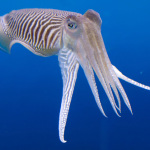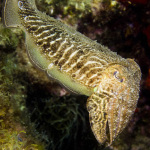Cuttlefish become stressed when exposed to shipping sound and panic when exposed to loud, low-frequencies, according to two scientific papers published this year. The Marine Life Society of South Australia believes that these results should trigger increased research efforts into the impact of shipping noise on the Giant Australian cuttlefish aggregation at Point Lowly, near Whyalla in South Australia. They argue that the matter is time critical, given anticipated shipping increases should current iron ore export plans receive environmental approvals this month.
In a study published in The American Naturalist in October, the European common cuttlefish, Sepia officinalis, showed signs of stress when exposed to recordings of shipping noise. The test subjects changed their visual and tactile behaviour more rapidly when exposed to recordings of a small ferry played back in a laboratory environment.
Another study, published in The Journal of Experimental Biology in November, investigated the sensitivity of the species, and graded the animals’ responses to bursts of specific frequencies of sound. The cuttlefish ejected ink and jetted away from the sound source when exposed to high intensity, low frequency sounds. Behaviours at other frequencies included startle and avoidance responses.
“These findings could be significant for the giant Australian cuttlefish of Point Lowly, which is similar in size to the European common cuttlefish. The proposed Port Bonython iron ore export facility, if approved, will construct a new wharf through the cuttlefish breeding reef. A new port will mean more ships coming closer to the Black and Stony Point aggregation sites than ever before,” said Dan Monceaux, Secretary of the Marine Life Society of South Australia.
“The vessel recorded for use in the first study was a minnow with a gross weight of 312 tonnes. The Capesize ore-carrying vessels likely to use the proposed Port Bonython wharf would carry around 175,000 tonnes of ore each and would emit much lower frequencies of sound due to their larger hull, engine and propeller sizes. Cuttlefish respond badly to loud, low frequencies.”
A former study published in 2011 revealed that low frequency sounds can potentially do more than create stress or panic among cuttlefish- they could also maim or kill the animals.
“Most shipping emits sound at frequencies below 300 Hz. In the second study, test sounds below 200 Hz evoked the strongest panic responses in the most recent study. The frequencies below 80 Hz remain untested on any cuttlefish species. It would be inappropriate for the Port Bonython wharf proposal to receive environmental approval in light of this new evidence… and in absence of any relevant study using the giant Australian cuttlefish as the subject.”
The Port Bonython Bulk Commodities Export Facility published an environmental impact study in October 2013. Since that time, its environmental approval by Federal and State governments has been delayed and extended four times. The most recent time extension ends on December 31. The port is one of several proposed for Spencer Gulf. The Marine Life Society of South Australia believes that any future ports should be sited away from sensitive receptors such as the Giant Australian cuttlefish breeding reef, little penguin colonies and sea and shore bird breeding habitats. Northern Spencer Gulf port locations are additionally confounded by shallow water and a narrow, constrained shipping channel with tidal impediments.
“The last thing the giant Australian cuttlefish of Northern Spencer Gulf could want for Christmas is a new port and an influx of ships and shipping noise.”




